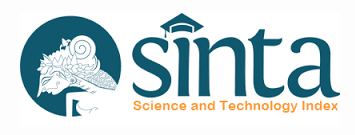PEMBINAAN KELUARGA SAKINAH PERSPEKTIF DAKWAH FARDHIYAH DI KELURAHAN BORONG KOTA MAKASSAR
Abstract
This paper discusses the Sakinah family coaching with a perspective of Da’wah Fardhiyah in Borong Village of Manggala District of Macassart City. This paper investigates the issue by addressing it elaborates the Da’wah Fardhiyah methods for Sakinah family coaching. The factors are related to economy and aqida (faith). The aims of this issue is “How the method of Sakinah family coaching with a perspective of Da’wah Dardhiyah in Borong Village of Manggala District of Macassart City.
In investigating the issue, this paper employ field research design by using personal communication approach and interpersonal da’wah approach. Furthermore, the samples for this research were selected using purposive sampling technique. This research collect primary and secondary data using interviews, observations and documentations. It processes the research data qualitatively through data reduction and conclusion. The data validity is achieved through four data triangulation methods, namely method triangulation, triangulation between researchers, data source triangulation and theory triangulation.
Conclusion of Sakinah family is an ideal concept of a happy family. This research implies that Sakinah family can be achieved by maintaining strong will as well as good relationships with Allah, family members and show mutual love, undertanding, respect and helpfulness and good community members.
References
Ahmad, A.Kadir. (2003). Dasar – dasar Metodologi Penelitian Kualitatif. Makassar: Indobis Media Centre.
Al-Majlisi, Syeikh Kabir.(1988). Sendi-sendi Pokok Rumah-Tangga Keluarga Rasulullah. Cet.I Gema Risalah Press Bandung.
Al-Mujahra, Nurul. (2017). Doa-Doa Suami, Istri dan Anak yang diaanjurkan Rasulullah Dan Paling Dicintai Allah. Cet.I; Yogyakarta: Araska.
Arifuddin. (2015). Keluarga dalam Pembentukan Akhlak Islamiah. Yogyakarta: Ombak.
Azis, Ali Moh. (2004). Ilmu Dakwah. Cet. VI; Kencana, Jakarta .
Basit, Abdul. (2017). Konseling Islam . Cet.I; Depok Kencana, Jakarrta.
Bogdan and Taylor. (2009). Metodologi Penelitian, Sebuah Pengantar.
Clase, Cyril. (2002). Ensiklopedia Islam. Cet.III; PT. Raja Grafindo Persada, Jakarta.
Dahlan, Abdul Azis. (1997) Ensiklopedi Hukum Islam, Juz 4 Jakarta ; Ikhtiar Baru Van Hove.
Gay, L.R., and Geoffrey E.Mills, Peter Airasian. (10th ed.2012) Educaation Research: Competencies for Anaalysis and Application. USA: Pearson Education Inc.
Gunawan, Imam. (2016). Metode Penelitian Kualitatif Teori dan Praktik, Jakarta: PT Bumi Aksara.
Ilaihi Wahyu. (2013).Komunikasi Dakwah. Cet. II PT. Remaja Rosdakarya, Bandung.
Mahmud, Ali Abdul Halim. (1995). Dakwah Fardiyah Metode membentuk Pribadi Muslim. Cet.1:Gema Insani Press.
Muhmidayeli. (2011). Filsafat Pendidikan. Cet.I; Bandung: PT Rafika Aditama.
Munawir, Ahmad Warson. (1997). Kamus al-munawir Arab-Indonesia . Cet.XIV, Surabaya; Pustaka Progresif.
Nuh, Sayid Muhammad. (2000). Dakwah Fardiyah Pendekatan-Peendekatan Personal dalam Dakwah. Cet.II; Era Intermedia Surakarta.
Provinsi Sulawesi Selatan, Departemen Agama. (2004). Proyek Peningkatan Pelayanan Kehidupan Beragama Sulawesi Selatan Bidang Urusan Agama Islam, Membina Keluarga Sakinah.
Sayekti, Pujosuwarso. (1994). Bimbingan dan Konseling Keluarga. Yogyakarta: Menara Mas Offset.
Qurasih Shihab,M. (1994) Membumikan Al-Quran. Fungsi dan Peran Wahyu Dalam Kehidupan Masyarakat. Bandung: Mizan.
--------------------- (2002). Tafsir Al-Misbah: pesan, kesan dan keserasian Al-Quran, Vol.11; Jakarta: Lantera Hati.
RI, Kementerian Agama. (2015). Al-Quran dan Terjemahnya. Jakarta: PT. Dharma Karsa Utama
Ridwan, Muhammad Saleh. (2013). Keluarga Sakinah Maa waddah Warahmah. Cet. UIN Press Makassar.
Ahmad, A.Kadir. (2003).Dasar – dasar Metodologi Penelitian Kualitatif. Makassar: Indobis Media Centre.
Al-Danawi, Saifuddin Aman, Nikmatnya Berumah Tangga. Cet. Pustaka Al Mawardi 2006.
Once an article was published in the journal, the author(s) are:
granted to the journal right licensed under Creative Commons License Attribution that allows others to share the work with an acknowledgment of the work's authorship. permitted to publish their work online in third parties as it can lead to wider dissemination of the work. continue to be the copyright owner and allow the journal to publish the article with the CC BY license receiving a DOI (Digital Object Identifier) of the work.





